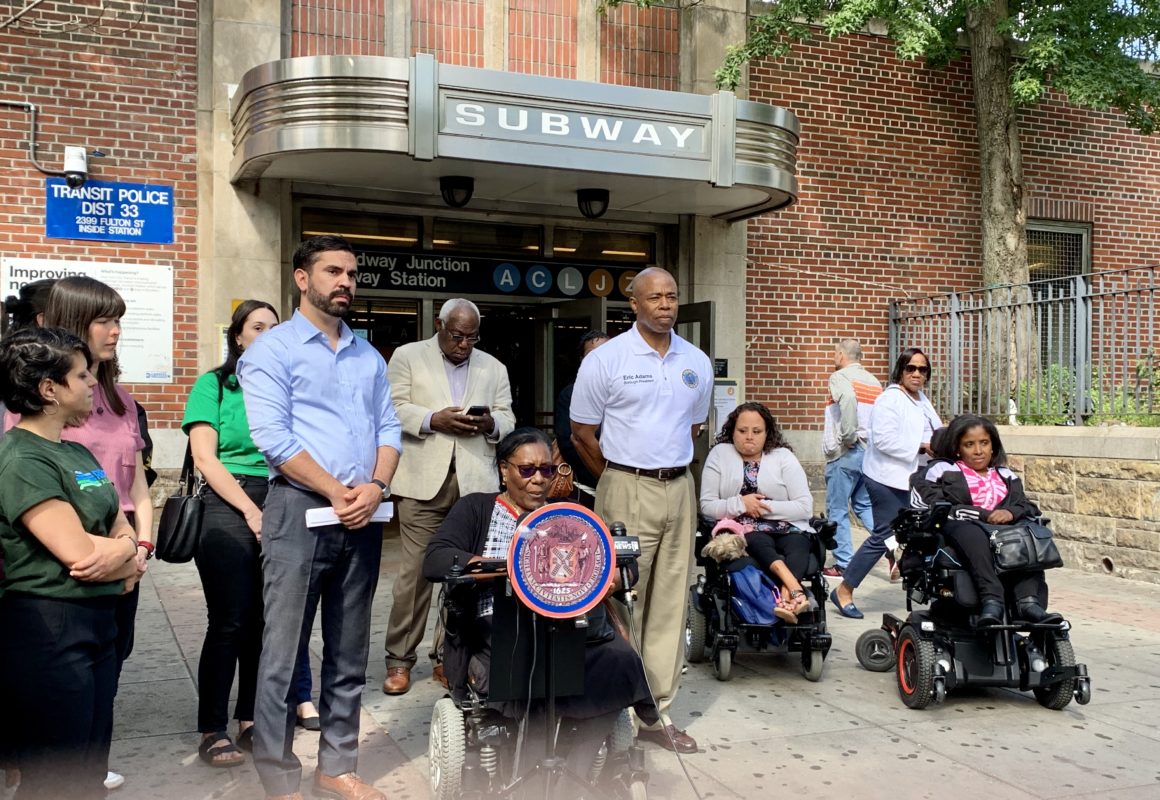Local leaders rally for accessibility
On August 26, local leaders, Councilmember Rafael Espinal and Brooklyn borough president Eric Adams, stood by disability rights advocates outside the Broadway Junction subway station – the third busiest in Brooklyn – and called on the Metropolitan Transit Agency to deliver long-awaited accessibility improvements.
“The MTA has been M.I.A. when it comes down to some of the residents here,” said Brooklyn borough president Eric Adams.
Monica Bartley, a Bushwick resident and community outreach organizer for the Center for Independence of the Disabled New York, waited in her wheelchair after the rally and watched her coworker retreat into the station to catch a ride to work. Because the station has no elevators, Bartley had to wait for an Access-a-Ride van, New York City’s Paratransit service.
On any given weekday, nearly 100,000 riders scurry up and down the stairs of the station. Almost never within eyesight, though, are wheelchairs or other devices to help with mobility issues. Without an elevator, the Broadway Junction, like over half of the subway stations in New York, is not accessible to many New Yorkers. Disability rights advocates say it is unacceptable that 24 percent of the MTA’s 472 stations are not accessible.
MTA announces $5.5 billion accessibility investment
On September 19, the MTA announced a $5.5 billion investment in accessibility improvements – namely the installation of elevators – to 70 transit stations, including the Broadway Junction, under its 20-24 Capital Plan, which is still under review. It’s seemingly a win for disability rights advocates, but some are skeptical of the promise.
“We haven’t brought out the champagne yet,” said Joseph Rappaport, Executive Director of the Brooklyn Center for Independence of the Disabled (BCID). “We want an actual guarantee that this work is going to move forward, and that is something that we haven’t been able to get from the MTA.”
According to the MTA, the majority of the 20-24 Capital Plan will be funded through bonds, with the remaining money anticipated from city, state, and federal funds, in addition to tolling and fare revenue. The $5.5 billion price tag attached to the project is steep, even compared to similar projects in other cities, and has some concerned about the MTA’s ability to come up with the money to fund the improvements.
“There is not really transparency on why those figures are so high,” said Jessica Murray, an organizer with the Rise and Resist Elevator Action Group.
MTA spokesman, Andrei Berman says the estimate reflects the wide range in cost of renovating stations, some of which were built before American Disability Act standards were in place.
The need for elevators is also a safety consideration. “I feel more vulnerable than anything else,” said Jessica DeLaRosa, a BCID systems advocate, who uses a wheelchair. “I don’t like people to know that I’m stuck or I’m lost, because as a person with a disability, you’re a target.” DeLaRosa said she was once stuck in a station without an elevator for nearly three hours, where she endured harassment as she waited for firemen to help her.
Advocates stress that just like people who use elevators in apartment buildings, hotels and offices, those who require subway elevators aren’t necessarily disabled. “Tired people use them, lazy people, people with strollers, people with little children, people with packages, people with suitcases,” said Jean Ryan, president of Disabled in Action, a disability rights group.
This January, a mother died after carrying her child’s stroller up the stairs of the 7th Ave. Manhattan station, which has no elevator. Her death awakened calls for accessibility throughout the five boroughs.
Legal action
Disability rights advocates have fought the MTA for years for the accessibility features they believe are legally required under the American Disabilities Act.
In March, US District Judge Edgardo Ramos ruled that the MTA violated the American Disabilities Act in 2014, when it renovated the Middletown Road subway station in the Bronx without installing an elevator. Experts say the decision set a precedent for similar challenges against the MTA.
Rappaport says his organization currently has three open lawsuits against the MTA. They are joined by a number of disability rights groups seeking a court order, which would require the MTA to install elevators in all renovated stations. Rappaport sees this kind of legal action as a necessary complement to advocacy. “Once you get sued, it usually wakes you up,” said Rappaport. “The lawsuits have played a significant role in altering the MTA’s outlook on accessibility.”
Ryan agrees. A legal agreement from the MTA would mean that “we wouldn’t have to be dependent on them to do this out of the kindness of their hearts.”
Some people with disabilities will see their accessibility options soon improve. The MTA has fast-tracked four of the 48 stations identified for improvements, by adding them to the 15-19 Capital Plan. Three of those stations are in Manhattan and one is in the Bronx.
“We will continue to advocate until every station in the system is upgraded and accessible for those with disabilities, specifically stations in neighborhood of color like the one the council member represents,” wrote Lloyd Lesperance, Councilmember Espinal’s chief of staff.
For advocates, the goal is a fully accessible subway system, and the MTA still has a long way to go. Even if all 70 stations are renovated to include elevators as planned, less than half the city’s stations will be accessible. Advocates would also like to see more Braille signs, platform-edge warning strips, and improved Access-a-Ride service to fill in the gaps.
Disability advocates say one of their biggest goals is spontaneous travel – to be able to go where they want, when they want. They remain cautiously optimistic as they await the elevators that may bring them a step closer to this goal.


Leave a Reply